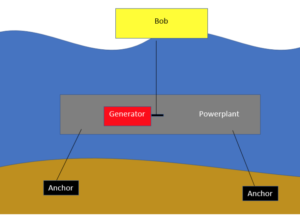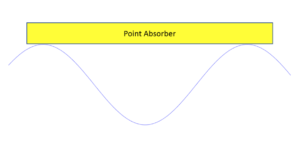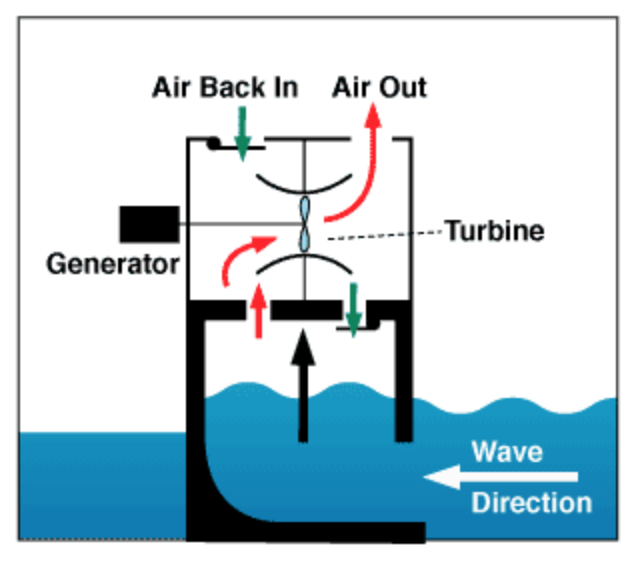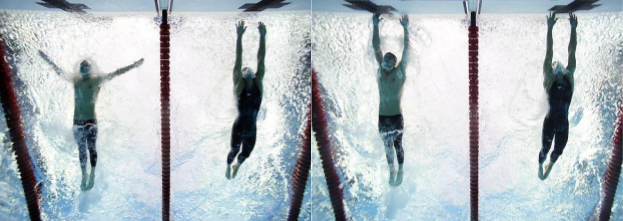As fossil fuels become less viable as a long-term energy solution and the effects of global warming continue to worsen, new renewable energy solutions are in high demand. Solar, wind, hydro, and geothermal energies are now extremely popular and produce significant amounts of the world’s energy resources. Another budding form of renewable energy is ocean wave energy. Wave Energy Converters, WECs, have been researched for decades but face immense obstacles involved with harvesting energy from such a turbulent source: the ocean’s waves. The benefits of WECs are huge, but overcoming these obstacles is a challenge in progress that we may not be ready or technologically equipped to tackle quite yet.
Everybody knows the statistic: the ocean covers 71% of the Earth’s surface. Nearly the entire ocean surface is turbulent and consists of waves of various sizes at various frequencies. Perhaps the incessant fluctuations of the ocean could be used for something better than causing seasickness. Imagine if we could harvest the energy of these waves and use them as a renewable resource to power our cities. What if ocean wave energy could be as ubiquitous as solar, wind, or, dare I say it, fossil fuels? For the past 30 years, scientists and engineers have been working towards this exact goal. Different approaches have been proposed, tested, scrapped, improved, and tested again in an attempt to make wave energy a more viable energy resource. Despite the massive benefits that wave energy could bring, the ocean is a harsh environment and certainly has its obstacles for wave energy converters (WECs).
The Technology
All renewable and even non-renewable energy production systems work in a similar fashion. In some way or another, an energy source acts on a mechanical system to drive a generator, with the exception of solar. Wind turbines drive huge generators. Hydroelectric plants take advantage of water pressure from dams and use fast-moving water to drive large hydro-turbines connected to generators. Fossil fuels are burned in large plants to create high-temperature, high-pressure steam to drive turbines. Proposals for WECs use the same generator-centric process by taking advantage of the bobbing of the ocean.
There are a few different designs for WECs, but most have the same concept of a large, floating bob sitting on the ocean’s surface. In the most prevalent type of design, the point absorber design, the bob moves up and down in an oscillatory motion with the waves, anchored or connected to a fixed power generator anchored to the ocean floor. One design has the bob connected to a series of ropes connected to winches on generators, so as the bob travels up and down, it winds and unwinds a cable to rotate a generator shaft and generate power [1]. Other designs use a hydraulic system instead of cables, so that the bobs act on pistons to generate power [2]. One less common point absorber design uses an electromagnetic induction generator instead of pulley or piston-based solutions to decrease mechanical friction, though this technology is more difficult to use in the ocean and many magnetic components are too dense for floating applications. This first group of designs can be placed in large arrays in the ocean. A simple schematic is shown in Figure 1.

Figure 1: Simplified Point Absorber Schematic
Another completely different design exists where tubes sit oriented along the direction of wave propagation, and bend and flex with the motion of the waves. Inside the tube are hydraulic mechanisms that generate power as the tube is bent and contorted. This design is called an attenuator, and has been implemented as part of an electrical grid in Europe. It is pictured in Figure 2.

Figure 2: Attenuators and Wave Alignment [8]
Another existing solution called terminator designs operate by allowing subsurface water to enter large chambers, creating pockets of air in the columns. As the water moves in and out of the chamber with the waves, the compressed air flows in and out and powers a wind turbine to create electricity [3]. A schematic of the terminator design is picture in Figure 3.

Figure 3: Basic Terminator Schematic [9]
Benefits
Wave energy collection has significant benefits–the ocean contains an unimaginable amount of energy in its waves. If we were capable of extracting even 0.1% of the global ocean energy resource, we could supply enough energy to power the world five times [4]. Although harnessing that much energy at a high enough efficiency level is a pipe dream, the statistic reveals the power behind ocean energy as another renewable resource to tap in to. Additionally, ocean wave patterns are often easier to predict and more consistent than wind patterns and weather [2]. Wave amplitudes and frequencies are relatively stable over time, making it easier to continually harvest energy. One of the final benefits of most WEC designs is that they are nearly invisible from the shore [2]. Though they’re not necessarily unpleasant to look at, solar and wind farms take up large droves of land. It is also important to note that ocean wave energy would be classified as a renewable resource, and large subsidies would be given to companies implementing the technology, in a very similar fashion to solar and wind energy.
Issues
With the large benefits of WECs also come a great number of setbacks. First, as with most renewable resources, ocean wave energy costs far more to extract per Watt than fossil fuels [2]. One WEC developer claims to be able to produce a 5 MW unit for $6.25 million, which comes out to a final rate of $1.25 per Watt [5]. Even with this somewhat optimistic estimate, the price is comparable to solar which is consistently the most expensive source of energy, nearly twice the cost of natural gas [6].
In addition to the cost problems there are many problems with WECs due to random variations in wave frequencies; this issue is devastatingly difficult for point absorbers and attenuators. Though, as discussed above, wave properties are relatively stable over multi-day timescales, small variations in waves occur frequently on the minute scale and can throw off energy collection systems [2]. Since wave amplitudes and frequencies are so low, with a wave passing every few seconds, point absorbers and attenuators operate best at very specific frequencies and amplitudes, and rely on consistent oscillatory motion to generate power due to their size and weight. When the regular motion of these waves is disrupted by an untimely wave or boat wake, the cycle of movement is thrown off. Thinking about the properties of waves, like wavelength and frequency, it would make sense that variations in wave properties would create problems for the collection systems. A good example is a weight moving up and down on a spring: if its consistent motion were thrown off by a small disturbance or push, the system would lose most of its oscillatory motion and a healthy portion of its energy.
Consider a wave with a wavelength of 8 feet (the distance between wave crests would be 8 feet apart). If you have a point absorber with a moving bob that is wider than 8 feet, the effect of the wave is completely lost and the bob would sit atop the crests without oscillating up and down. See Figure 4 for a picture of this phenomenon. Even for bobs slightly shorter than Figure 4, efficiency would drop significantly in these scenarios. The placement of these bobs and their predicted waves are extremely important for consistently high efficiencies. Multiple uncharacteristic disturbances could potentially keep the system from operating entirely.

Figure 4: Oscillating Bob Wavelength Issue
In a similar strain of concern for these products, the ocean has varying qualities at different latitudes and locations on various coasts. WECs are estimated by many scientists to have the highest potential efficiencies in northern North America (NJ, NY, CT, OR, WA), most of Northern Europe, and some points off Australia and Peru due to wave size, ocean depth, and low wave frequency [2]. In other locations, efficiencies can drop to as low as 60% of these maximum values. Moreover, with different wave properties come different design considerations, namely size and weight, and new specifications must be developed for different conditions. This makes these systems difficult to develop for universal use and maximum efficiency. As shown by Figure 4, the size of these bobs must be designed specifically for certain wavelengths. Different areas around the globe will require vastly different bob sizes for maximum efficiency.
It is also important to point out that the ocean is a hostile environment. Seawater is corrosive, and marine life like algae, barnacles, and fish could potentially damage sensitive machinery. Storms, too, could be extremely damaging and costly in terms of repairs to these devices. Though terminators do not face as many ocean-based wave oscillation issues since they sit on land, terminators would take up substantial shoreline property, unlike their mid-ocean counterparts. This creates the same dilemma that exists now of oil refineries on shores taking up valuable real estate.
The Future?
One company in the United Kingdom called Pelamis Wave Power created an attenuator and anchored it off the coast of Portugal to generate power back in 2009 [7]. The system was deployed for about three years for testing and use until it was retired due to excessive costs and inefficiency. Pelamis is the only substantial example of a WEC that has been put to work at a large scale, connected to a power grid. Almost all of the technology behind WECs that exists currently is in development stages in basement research labs at universities, years away from finalized implementation. Right now, the cost of WECs is only marginally better than solar, the technology is not reliable, and none of the three systems would be adaptable to different environments, making them difficult to produce and install at a large scale. It is important for universities to continue researching new technology and ways to tackle the consistency problem of wave energy. For now, other renewable resources must first improve and continue to move us away from harmful non-renewable resources to pave the way for developing WECs and other forms of upcoming renewable energy resources.
Suggested Links for Further Reading:
- Point Absorbers and Some Energy Analysis: https://martinottaway.com/mraftery/approaches-to-replacing-fossil-fuels-with-ocean-wave-power/
- Detailed Wave Property Issues: http://science.sciencemag.org.libproxy1.usc.edu/content/323/5918/1176
- Some Cool Implementations of This Technology:
https://www.boem.gov/Ocean-Wave-Energy/
Suggested Multimedia Applications:
- Moving animation of one or all of the devices, if possible
- Video of different ocean conditions
- Video of the Pelamis Wave Converter
References
[1] M. Raftery and R. Stolkin, “Ocean Surface Wave Energy Harnessing Development at Stevens Institute of Technology (SIT),” Oceans 2007, 2007.
[2] J. Scruggs and P. Jacob, “Harvesting Ocean Wave Energy,” Science, vol. 323, no. 5918, pp. 1176–1178, Feb. 2009.
[3] “Ocean Wave Energy,” Bureau of Ocean Energy Management. [Online]. Available: https://www.boem.gov/Ocean-Wave-Energy/. [Accessed: 10-Sep-2018].
[4] S. Merry, “Soapbox,” Sea Technology; Arlington, vol. 46, no. 4, pp. 85–85, Apr. 2005.
[5] M. Raftery, “Approaches to Replacing Fossil Fuels with Ocean Wave Power,” Martin Ottaway, 19-May-2018. [Online]. Available: http://www.martinottaway.com/blog/michael-raftery/approaches-replacing-fossil-fuels-ocean-wave-power. [Accessed: 10-Sep-2018].
[6] “Comparing the costs of renewable and conventional energy sources,” Energy Innovation: Policy and Technology, 31-Jan-2018. [Online]. Available: https://energyinnovation.org/2015/02/07/levelized-cost-of-energy/. [Accessed: 10-Sep-2018].
[7] “Pelamis Wave Power,” EMEC European Marine Energy Centre. [Online]. Available: http://www.emec.org.uk/about-us/wave-clients/pelamis-wave-power/. [Accessed: 10-Sep-2018].
[8] The concept of the Pelamis with hydraulic conversion system. PelamisPower.
[9] C. Houghton, Basic Terminator Schematic . MWPS World Limited.




